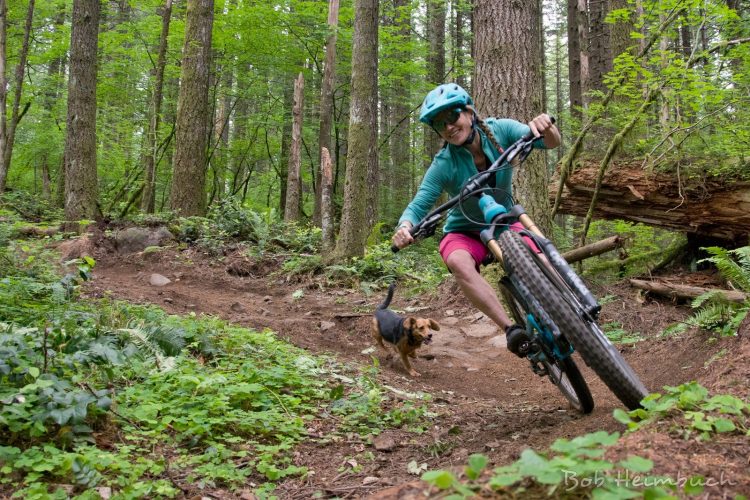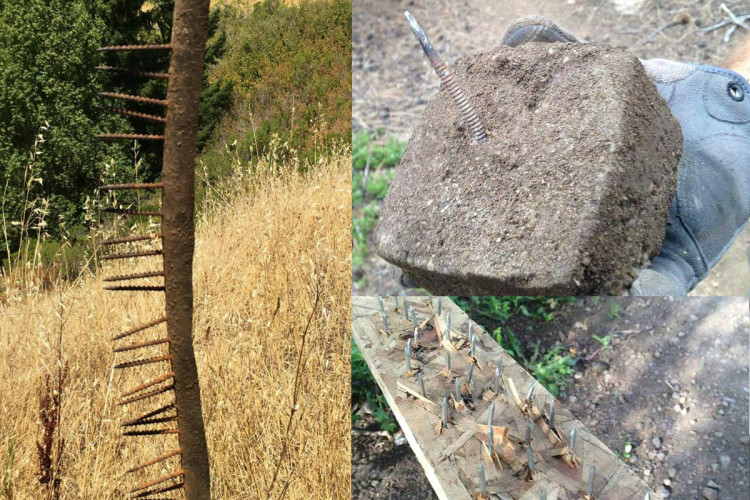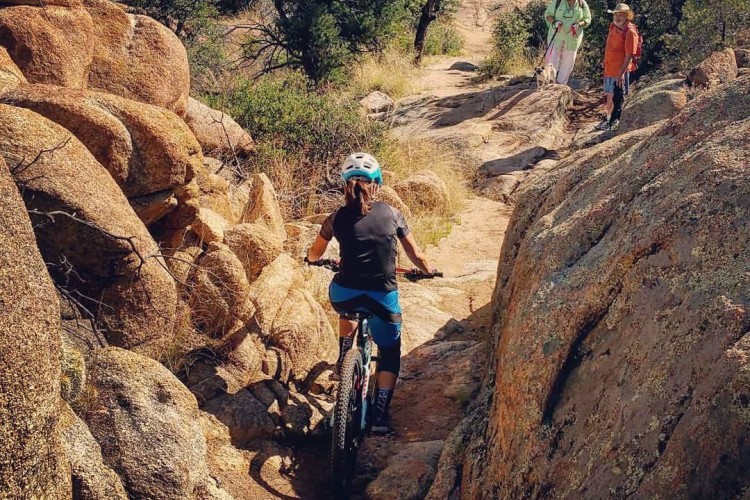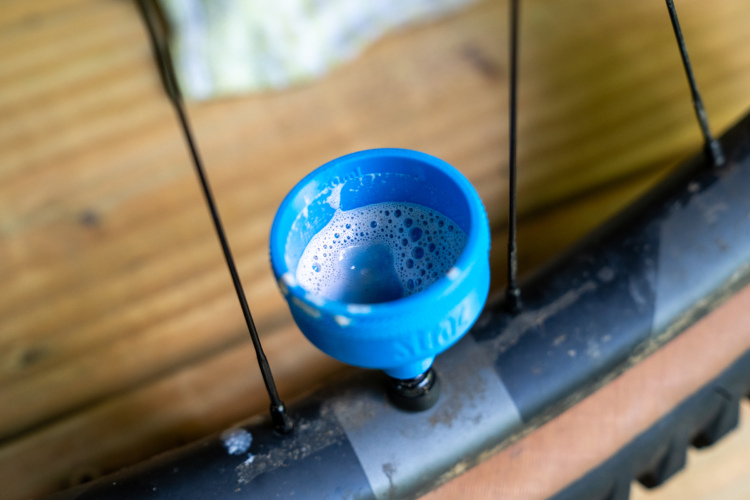
Editor’s Note: “Over a Beer” is a regular column written by Greg Heil. While Greg is the Editor in Chief for Singletracks.com, any opinions expressed in this column are his alone and do not necessarily represent the opinions of Singletracks.com.
The alarm clock squawked obnoxiously at 6am, jerking me rudely from my slumber. I wiped my bleary eyes and tried to figure out what the heck was going on.
“Seriously, what is going on right now? It’s dark outside, why is my alarm going off?” But then I remembered, “Hey, I’m going riding this morning!” It had been four days since my last ride, so I was due for a sanity check, an appointment with the two-wheeled psychiatrist.
[see_also id=”198924″][/see_also]
I slurped down some coffee, tossed my gear in the truck, drove into town, ran some errands, and hit the trailhead about 7am. It was colder than I expected it to be: 17 degrees. Yet, the frigid air was part of the plan.
I’ve only lived in Salida for about three and a half years, but I had quickly learned to interpret the local freeze/thaw cycles. In no time I had learned how the trails melt out after a big snow storm, and the fact that, right now, if I didn’t ride while it was frozen, I’d be leaving big ruts every time I turned into the shade. Since I had to log on and get work done later, I had decided to set my alarm for o’dark’thirty to get my much-needed singletrack time in while I wouldn’t be damaging the trails, and before I had to get to my day job.
I decided to sacrifice some precious sleep and suffer through 17-degree weather, because I want to take care of these trails. Because they are my trails–my local trails. Our local trails. The trails built by our community and maintained by our community. Our trail system is truly a community resource, and I wanted to take care of them. So I got up early.
Imagine my surprise when I began pedaling up the trail and in the second corner, I faced a long stretch of ruts. And in the third corner. The 10th corner. The 15th corner.
On and on, for miles and miles, throughout my entire ride: ruts, ruts, ruts.

And while it would be easiest to blame the mountain bikers, the tire tracks commingled with foot prints and paw prints. Oftentimes the impact from the hikers and the runners was even worse than the riders, as they attempted to step around the puddles, thereby widening the trail–making singletrack not single anymore. But really, that’s neither here nor there. Discussing who’s damaging the trails the most in muddy conditions is like asking who’s the guiltiest in a bank heist: the guy waving the gun, or the guy filling the sack with cash. They’re both guilty.
Leaving ruts in a trail that’s dry over 90% of the year is an act of pure selfishness. Pure selfishness and lack of consideration for the rest of the community members that also enjoy these trails, that have helped build these trails, that have donated time, money, blood, sweat, and tears to make these trails a reality.
Whenever we write about riding wet trails on Singletracks, someone jumps in and starts talking about how trails in Washington are always wet. Well, that’s not what I’m talking about here. Our local in-town trail systems, specifically the Arkansas Hills Trail System in this case, is located in a high desert environment. The trails are dry and sandy almost the entire year. For a few weeks here and there they’re buried in snow (which also doesn’t hurt the trails)… the only time they’re susceptible to serious damage is for the week or two when they’re drying out after a major snow storm.
Now I won’t go so far as to say that ruts from tire tracks and foot prints significantly degrade the environment by adding silt to the streams, displacing plants, disrupting animals, etc. That’s simply not true, and even if a little dirt is displaced, it’s not significant. Stay tuned for an upcoming column on this meta topic.
Rather, the damage is to the trails themselves, and to the experience of the users on the trails. Since this trail network is dry 90% of the year, these ruts will often harden into cement-like trenches and divots, making the trail surface unpleasant and difficult to use for riders and runners alike. Riding through and around mud holes both deepens and widens them, requiring volunteers to come in with tools to repair the damage and de-berm the trail to allow it to drain again.
This is why rutting up trails is a selfish act. The trails must be repaired, or the degradation will only accelerate. So volunteers will have to selflessly give of their free time and energy in order to repair this damage, damage caused by an outing in the mountains that could have been simply taken at a different time of the day (when the trails were frozen, as I did), or in a different location (on a paved or dirt road, or on a snow-covered trail higher in elevation via a fat bike, snowshoes, or skis). There are a multitude of ways to get your exercise fix that don’t involve the destruction of a valuable community resource.
As I pedaled along, I couldn’t help but think about the amount of time and effort that will be required to fix this rampant damage, and how much new trail could be built with that same amount of energy. Instead of focusing on building brand-new singletrack, that precious volunteer labor will be spent repairing the damage caused by selfish trail users who didn’t take the time to think about the consequences of their actions.

My deepening despair reached rock bottom when I came to the newest addition to our trail system: Chicken Dinner. Salida Mountain Trails contracted Tony Boone’s professional trail building crew to craft a brand-new two-mile singletrack trail, and this would only be my second time riding it since it was opened in early December
This is no mere rake and ride: Chicken Dinner is a carefully-crafted masterpiece filled with berms, rollers, jumps, chunky sections (that will only get chunkier with time), and sweet, sweet flow. This sweet flow comes at a cost, though–the price tag on Chicken Dinner was a little over $40,000.
And my heart sank as I started seeing ruts in this brand-new $40,000 work of art.

While I have the privilege and the responsibility of serving on the board of Salida Mountain Trails and having a say in how SMT’s money is spent, this wasn’t my $40,000 that was spent on this trail.
This was our $40,000.
SMT raises money from local businesses like the Boathouse Cantina. From local dues-paying community members like myself. From grants from the city, county, and state governments. Simply put, we have worked diligently as a community to save money to get this trail built, to keep expanding our world-class network of singletrack. But when I see people who apparently do not care about this investment of time and money, my heart breaks.
Thankfully as I continued down Chicken Dinner, I realized that the vast majority of the trail was south-facing and largely dried out. Thankfully, the ruts in our latest work of singletrack art were minimal. But that doesn’t negate the damage to the rest of the trail system.
The moral of the story? Ride when it’s frozen, go ride somewhere else, or don’t ride at all.











20 Comments
Feb 10, 2017
This is simply a bogus statement. whether it be with bicycles, motorcycles/quads or even 4x4 trucks. The narrower the tires the deeper the ruts in mud. Which causes more damage in the mud, a tennis shoe or a woman's high heel shoe? The high heel of course because it takes the weight normally distributed across the entire soul of the shoe and concentrates it into one small area. Same with tires. 1 to 2 inch tires cause the most damage on a trail. I have a fat bike and riding in these conditions, my fat tire flattens the ruts made by narrow tire mountain bikes and make the trail smooth again. In the motocross world. Motorcross riders hate quads on the tracks because they destroy the ruts made by the motorcycles in corners that help them corner, which quads with fat tires don't need to corner and level those ruts. I have heard that electric bikes are also the boogie man for destroying trails but studies have been done that standard electric assist bikes cause no more damage than a standard bike (if we start talking high power bike which are not allowed in any state right now and is illegal federally (over 750watts) then could possible cause more damage if ridden in a way that spins the tire).
I get do get tired of the misinformation. But regardless. I agree with some of the other posters here. Ruts are part of the sport, you just have to deal with it. Just like rocks in the middle of the trail that can cause you to crash. I have heard people say "I hate it when people pull rock obstacles out of the trail, it makes it too easy" so you will never make everyone happy.
What I think is selfish is one person who has a blog thinks he can tell everyone else when they can an cannot ride and if they can make ruts or not. We have to also deal with horses, people (many who do not keep their does on leashes which is required by law). But guess what those same people hiking have to deal with mtb riders who fly down the trails so fast there is no way they can stop if they meet up with a hiker/dog, or even another bike. Yesterday there was a mtb rider that flew by me and jumped a rock most people don't jump at about 40mph and startled me. I don't care about ruts, horses, hikers what I do care is when people put others in danger unnecessarily by riding too fast on a shared trail or when hikers have dogs that chase you or try to bite you. Those people are selfish. The same closed minded people would tell everyone we should not have horses on the mtb trails... or hikers... or fat bikes... or electric bikes... or slower less experienced riders... or people who do not think as they do... or republicans who automatically cause more damage to the trails because they are not liberal... or whatever.. talk about selfishness. Trails are public. If you want to tell people what they cannot do, buy your own private land, make your trails and decide who can an cannot ride them. Otherwise don't tell others what they can and cannot do outside the law. IMHO of course.
Feb 11, 2017
I don't think I said that. I believe I said I will not be having any more disagreements with you. But regardless if I did or not, unless we were taking over by communist China while I was sleeping, I believe living in the US allows me to change my mind.
Greg said "Did you even read this article, and the article you linked to?"
Why yes I did Greg so since you asked a question and I answered, perhaps in the course of civil discourse you will return the favor and answer mine.
So what you are saying is if it rains 90% somewhere in another country we have your blessing to create ruts there with no fear of reprisals including you calling us selfish? How about in this country? How about in our great state of Colorado, what if there is a place that rains 80 percent of the time there, do we have your permission to create ruts without being called selfish? How about if it rains 50 percent of the time? The weather looks like it might rain for Sun/Mon. How many days must I wait after it rains must I wait for the trails to dry out to get your permission to ride and not be in danger of being called selfish? Now what if I am out on a day when you give us permission to ride without calling us selfish and it is dry, but then it rains? Do I have to stop riding and must I walk out to still have your blessing and not be called selfish?
We are ignorant here Greg. Maybe you could post signs the explain when we have your permission to ride the public trails without the fear of you calling us selfish.
The reason I changed my mind is I had to point out this total hypocrisy on your part as when we can ride. Also that you are the elitist of the elite that we have to be concerned about you calling us selfish when we want to ride our bikes. Now in the snow if there is even a hint of sun here in Colorado, it melts and ruts start to form, should we be in fear of you calling us selfish when we ride our fatbikes in the snow.? I am going to ride red rocks opens space tomorrow Greg, do I have your blessing even though it might rain. LOL
Feb 8, 2017
Feb 9, 2017
Feb 9, 2017
Feb 9, 2017
To be honest i am guilty of the same thing but by accident. When i was new to the sport i didn't know that skidding into corners would cause deterioration (ruts). But now i am more experienced i have become more knowledgeable and have learned how to ride in a way that doesn't destroy my environment while having my fun. I think the problem isn't that people are selfish, it is they do not realise what they are doing. Education is the answer.
Feb 10, 2017
Those pics look like 8 or 10 riders did all that damage.
They will never read this article, or show up for a work party. "Dude, we drove all the way from Gotham, so we're going to ride!"
"Ice Mud" or "Freeze/Thaw" is the absolute worst for trail damage. Not at all like rainy, muddy trails.
Feb 9, 2017
Feb 8, 2017
Feb 8, 2017
Feb 8, 2017
Feb 8, 2017
Those of us who have lived out east, where rains so often and is always so humid that the next rain often comes before trails have dried out from the last, know what it's like to go without. A little perspective is a good thing.
Feb 10, 2017
Feb 10, 2017
(In my best Mr Rogers Neighborhood voice... "Children,.... can you say Hippocratic?... I knew you could."
Feb 10, 2017
Please don't comment if you haven't read the articles. Worse, if you can't understand the nuances of the different situations, why are you bothering to interject?
Last we heard from you, you said you were never coming back to Singletracks to read another post ever again. Glad I can at least count on one person to interject some negativity into my day.
Feb 10, 2017
Feb 16, 2017
Feb 8, 2017
Feb 9, 2017
Secondly, I appreciate your side comment early on in the article about ruts and trail damage as it relates to significant damage to the environment and streams. I am anxious to see your upcoming article. I have always felt that this issue has been highly overblown. In most cases a trail which is a tiny thread in a massive forest environment is not going to case significant degradation to an ecosystem or a local stream. In a rare few instances, maybe so. And in many cases just a little bit of rerouting, more contouring, adding some small water bars, and/or cambering the trail would resolve the issue. Some simple best management practices. If you want to be concerned about siltation of streams and impacts to ecosystems, then look into logging, not recreational trails, and even logging isn't as damaging as many want to say. As a silviculturalist, I prescribed all sorts of treatments in the forest including logging operations. And as a Forest Ecologist, I care about the forest and ecosystem as much as anyone. I have proved that by spending years of my life and own money to get degrees in forest management. The truth of the matter is that we can even log in forests without any long-term damage to the forest. Sometimes it's even helpful to the ecosystem. I could list numerous benefits. However, sticking close to the topic at hand, even things like breaking up the top of the soil profile just a little can be helpful at times. And of course these days, substantial buffers around riparian zones are enforced in logging operations. So all in all, there are much bigger threats to ecosystems than some damage to the tiny thread called a trail, but that still doesn't mean we should not care for the trails. We should, but mostly for the users' experience.
Feb 13, 2017